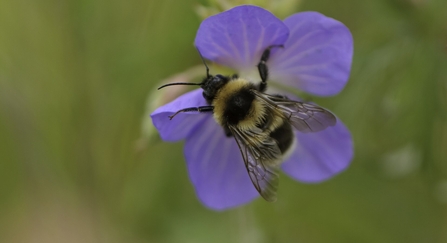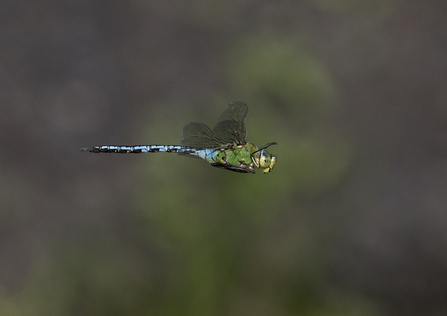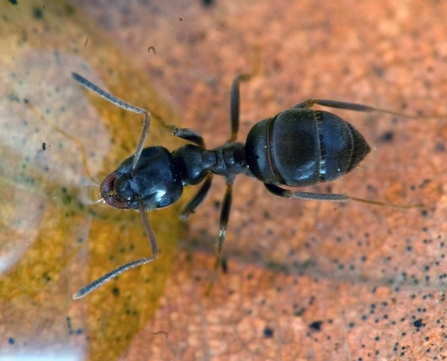These tiny creatures are essential pollinators (insects pollinate around one-third of the food we eat!), decomposers, and a food source for many animals. Without them, the balance of nature would be disrupted, leading to cascading effects on food production, biodiversity, and even climate regulation. Read on to discover some of the most common insects in the UK, where you can find them, and what’s so fascinating about each of them. If you’re buzzing about insects, find out how you can help support insect populations through citizen science initiatives like the Bugs Matter survey.
Flies (Diptera)
Often underappreciated and overlooked, flies play important roles within ecosystems, including pollination and decomposition. With around 7,000 species of fly in the UK alone, they are much more varied than you might expect! Flies are distinguished by only having one pair of wings, with the second pair evolving into small structures called halteres, which help them balance during flight.
Where to find them:
-
UK: Flies are found in nearly every habitat, including urban areas, forests, wetlands and grasslands.
-
Kent: At Ivy Hatch, one of our smallest reserves, over 55 fly species have been recorded in just one hectare of woodland.
Hoverfly (Helophilus pendulus) © Vaughn Matthews
Bumblebees (Bombus spp.)
Did you know that bumblebees use buzz pollination? They vibrate their bodies using their flight muscles to detach pollen from certain flowers, and therefore pollinating them. This is why bumblebees are so important for plants like tomatoes, aubergines and raspberries. They can fly at cooler temperatures and lower light levels than many other bee species, making them vital for early spring and late summer pollination.
Where to find them:
-
UK: Bumblebees can be found in gardens, meadows and woodlands across the UK.
-
Kent: Bumblebees thrive in places like Marden Meadows. Old Park Hill and West Blean and Thornden Woods are also excellent spots.

Garden bumblebee by Chris Gomersall/2020VISION
Small white butterfly (Pieris rapae)
Also known as the cabbage white butterfly, you can often see them fluttering around your gardens. Adult butterflies have taste sensors on their feet to help them find suitable host plants for laying eggs. Caterpillars hatch from the eggs, and later form a chrysalis (pupa) and metamorphose into an adult butterfly.
Where to find them:
-
UK: These butterflies are widespread in gardens, fields and hedgerows.
-
Kent: Queendown Warren and Romney Marsh are both great sites for butterfly watching. They also flourish in wildflower meadows and gardens.
©Les Binns
Ladybirds (Coccinellidae)
Ladybirds are nature’s pest control, feeding on aphids and other plant-eating insects. They’re a gardener’s best friend! There are 46 ladybird species found in the UK, and over 5,000 worldwide. Their characteristic bright red and black spot colouration on species like the Seven-spot Ladybird (Coccinella septempunctata) serves as a warning to predators of their toxicity. They excrete a bitter liquid when under threat as a further defence mechanism.
Where to find them:
-
UK: ladybirds are found in gardens, hedgerows and forest edges.
-
Kent: Sevenoaks Wildlife Reserve hosts a wide range of ladybird species.

Orange ladybird © John Bridges
Dragonflies (Anisoptera)
Dragonflies are ancient insects, with ancestors dating back over 300 million years. They have incredible flying capabilities thanks to their two pairs of intricately veined membranous wings. Unlike damselflies, the front and rear wing pairs are shaped differently. This allows dragonflies to hover, fly backwards and even reach speeds of up to 30 miles per hour! Dragonflies are also voracious predators, feeding on mosquitoes, midges and other small insects.
Where to find them:
-
UK: Dragonflies are often seen near ponds, lakes and river across the UK.
-
Kent: You can spot dragonflies at Stodmarsh National Nature Reserve and the wetlands at Oare Marshes and Ham Fen.

Emperor dragonfly © Chris Lawrence
Ants (Formicidae)
Ants are social insects, living in complex colonies with a strict division of labour among workers, and reproductive individuals. Some ant species can build massive underground nests that house millions of individuals. They communicate with each other through pheromones, leaving scent trails to guide other ants to food sources.
Where to find them:
-
UK: You can find ants nearly everywhere!
-
Kent: Ants are everywhere, from gardens to woodlands like West Blean and Thornden Woods. Lydden Temple Ewell also houses diverse ant colonies.

©️ Don Sutherland
Support insects through Bugs Matter
Insects are crucial to our ecosystems. Without them, life on Earth would collapse. However, their populations are under threat from habitat loss, pesticide use and climate change. You can help by participating in the Bugs Matter citizen science survey. This initiative encourages people to monitor insect abundance by counting the number of bugs splatted on their car number plates after a journey. The data collected helps us to track insect abundance changes over time.
It’s quick, free and easy to take part:
-
Register: Download the free app and register
-
Collect data: Clean your car number plate, tap ‘Start journey’ in the app, make your journey, then record the number of bugs splatted on your number plate once you reach your destination.
-
Submit data: Submit your insect count as well as a photo of your number plate in the Bugs Matter app.
By contributing vital data to this survey, you’re helping our team understand more about the plight of insect populations across the UK which can help to inform conservation strategies and better insect policy and practice. Anyone can take part across the UK – you are driving the data!
Insects are the unsung heroes of our natural world, performing vital roles that sustain ecosystems and human life. From the industrious honeybee to the stealthy dragonfly, each species has unique qualities and contributions. By learning about and supporting our insect populations, especially through citizen science surveys like Bugs Matter, we can ensure that these tiny titans thrive. Next time you see an insect, take a moment to stop and think about its role in the web of life.

